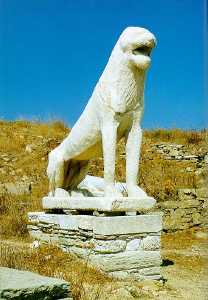|
The Cyclades Civilization
 The
civilization, which covers all of the third millennium BC and
was developed in the Cycladic islands, is the so-called
Protocycladic civilization. The factors contributing to its
development were: The
civilization, which covers all of the third millennium BC and
was developed in the Cycladic islands, is the so-called
Protocycladic civilization. The factors contributing to its
development were:
a)
The mild climate of the Cyclades, which are very accurately
characterized as the "Riviera of Greece".
b)
Their geographical position, a natural bridge between Europe
and Asia.
c)
The development of shipping and therefore of trade, and
d)
The self-sufficiency they had in spite of their limited land
area.
This
civilization developed in three major phases. The first was
from 3200 to 2800 BC and is called the Civilization of Pylos
(Clay), from the homonymous site on the island of Melos. The
second is from 2800 to 2200 BC and is the Civilization of
Keros-Seros and the third from around 2200 to 2000 BC. Many
archaeologists, both Greek and foreign, have excavated and
studied it. The most systematic excavator was the great Greek
archaeologist Christos Tsountas who carried out a multitude of
excavations in tombs and in settlements, and distinguished the
character of the Cycladic from the rest of the civilizations.
The
settlements were located in coastal sites and in the beginning
were without walls and guarding measures. But later, because
of fear of pirates, the Cycladites moved into the interior,
settled on the hills with sharp hill-sides and fortified
themselves with walls and towers. Then, when the Minoan
civilization predominated they moved back down to the coastal
areas. They lived in simple, straight-lined or curved houses
in fortified settlements. The walls were made of mud and
stones, the roofs were lightweight, made of reeds and
branches, the interior was of plaster varnishing and, because
of the mild climate or even because of firewood shortage,
there was no hearth. They buried their dead in box -shaped
tombs of a trapezoidal shape, in circular ones and in chambers
carved on the rock. Their religion consisted of a mixture of
superstitions and magic. The excavations and research have
shown that the Cycladites already had trade relations with
mainland Greece, the coastal areas of Asia Minor and with the
western Mediterranean, from the Neolithic period.
|
>> Cyclades Islands : Amorgos, Anafi,
Andros, Antiparos,
Delos, Folegandros,
Ios, Kea,
Kimolos, Kithnos,
Koufonisia, Milos,
Mykonos, Naxos,
Paros, Santorini,
Serifos, Sifnos,
Sikinos, Syros,
Tinos.
|
|